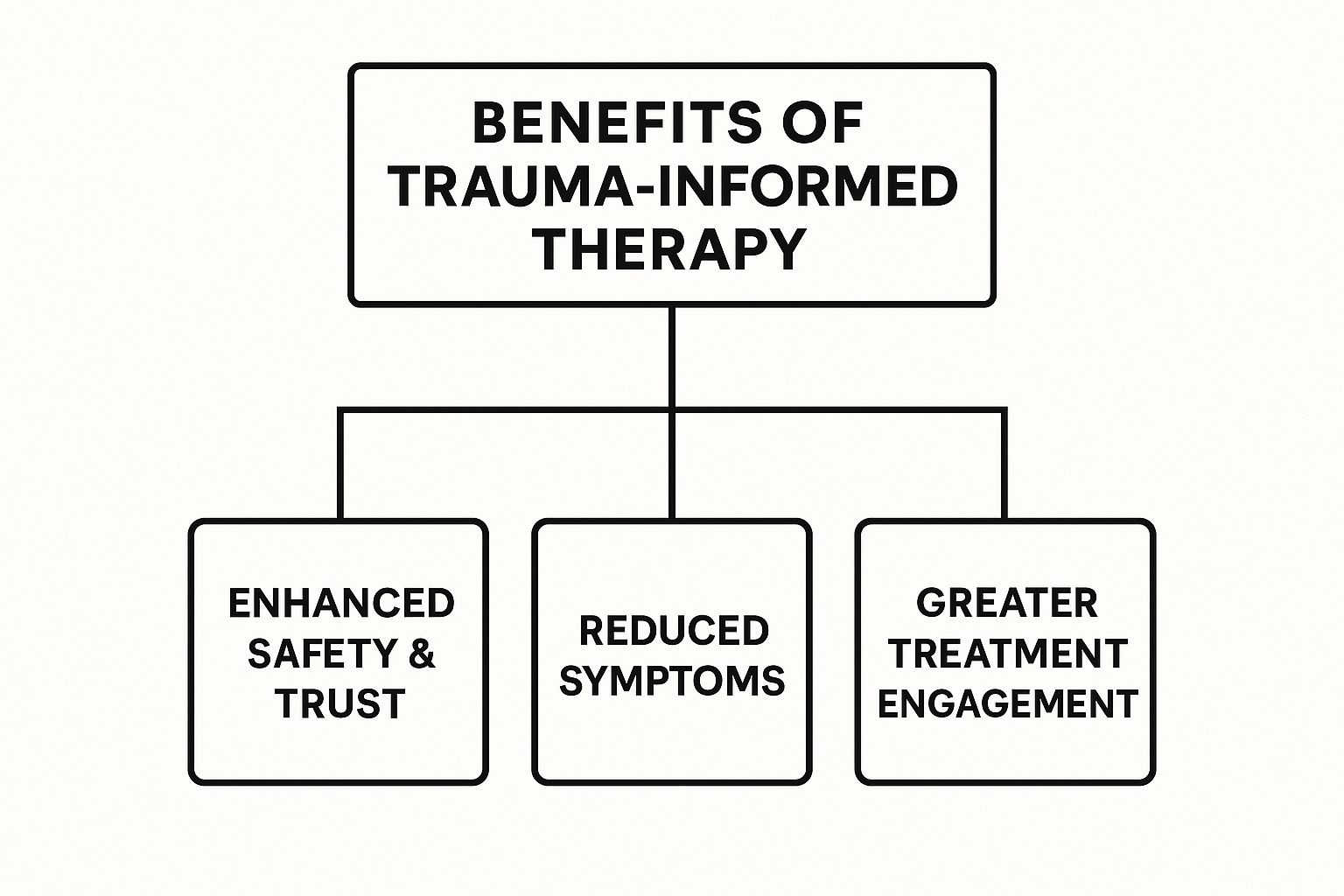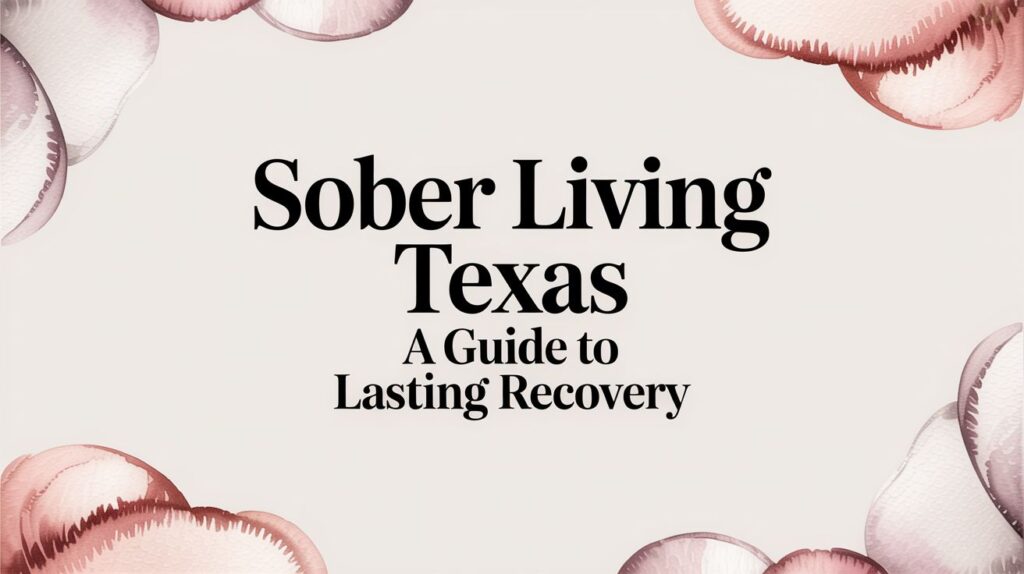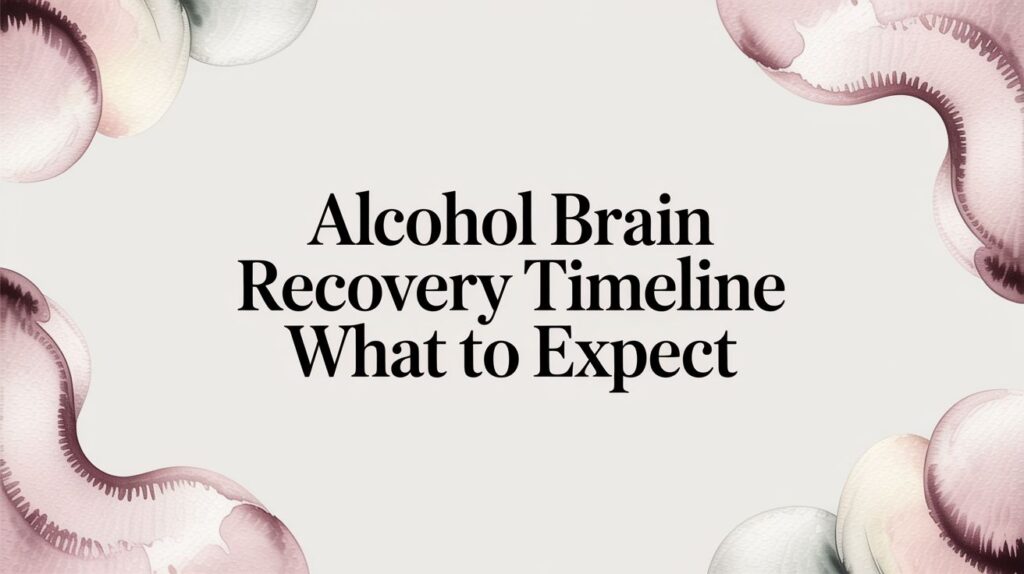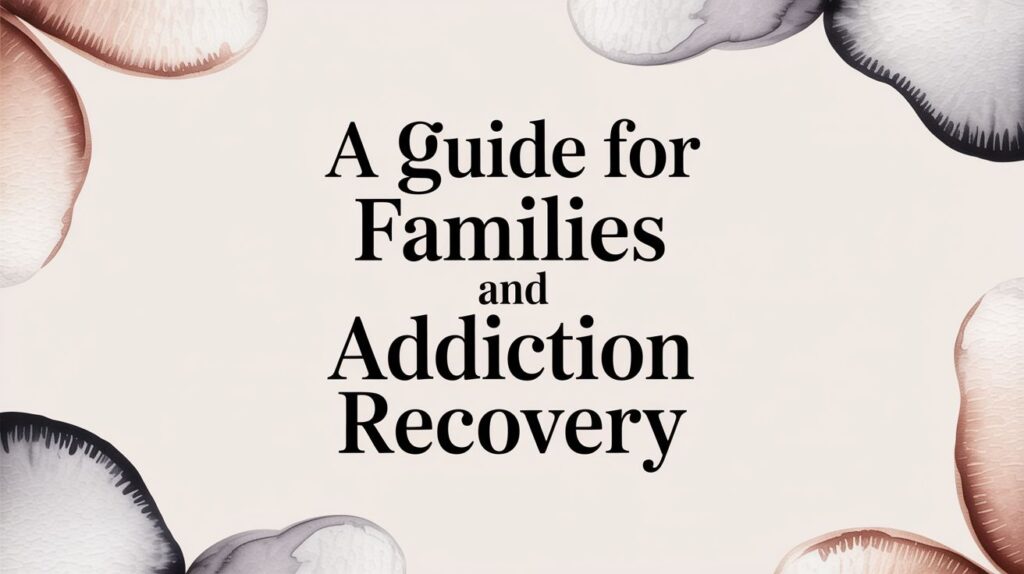Trauma-informed therapy isn’t a specific technique or a rigid set of rules. Instead, it’s a profound shift in the entire approach to mental health and addiction care. It’s built on one fundamental change in perspective: moving away from asking, "What’s wrong with you?" and toward gently asking, “What happened to you?”
This single question changes everything.
Shifting The Focus From Symptoms To Experiences
Think of a gardener who only yanks out weeds without ever checking the soil. The garden might look clear for a little while, but if the soil is unhealthy, the weeds will always come back. Traditional therapy can sometimes feel like that—focusing on behaviors and symptoms without digging deeper to understand where they came from.
Trauma-informed therapy, on the other hand, is like a master gardener. It understands that the soil—a person's life experiences—directly impacts everything that grows.

This framework acknowledges that overwhelming events can leave a lasting imprint on a person's brain, body, and relationships. What we often label as "symptoms"—anxiety, addiction, depression, anger—are frequently brilliant, creative survival strategies that a person’s nervous system developed to cope with what happened.
A New Lens For Healing
This approach isn’t a standalone therapy like CBT or EMDR. It’s a compassionate lens that colors every single interaction, ensuring that the healing environment itself doesn't accidentally cause more harm. The top priority is to create a space that actively resists re-traumatization.
Every conversation and every decision is guided by principles designed to rebuild the sense of safety, choice, and control that trauma so often takes away.
The core idea is simple but powerful: to heal, people have to feel safe. A trauma-informed space is one where clients are seen as the experts on their own lives and treated as partners in their own recovery.
By helping people connect the dots between their past experiences and their present struggles, therapists can validate their responses and help them make sense of their story. That validation is often the first real step toward healing, empowering someone to finally move beyond just surviving and into a life of resilience and growth.
Shifting Perspectives From Traditional To Trauma Informed Care
This table helps illustrate the fundamental mindset shift that occurs when moving from a more traditional model to a trauma-informed one. It’s less about changing tactics and more about changing the entire philosophy of care.
| Focus Area | Traditional Approach Asks | Trauma Informed Approach Asks |
|---|---|---|
| Client Behavior | "Why are you acting this way?" | "What are you doing to survive?" |
| Diagnosis | "What's wrong with you?" | "What happened to you?" |
| Treatment Goal | "How can we fix your symptoms?" | "How can we build safety and resilience?" |
Ultimately, this shift honors a person’s lived experience as the central part of their story, recognizing that their struggles are not a sign of weakness but a testament to their strength.
The Journey to Understanding Trauma's Impact
To really get what trauma-informed therapy is all about, it helps to understand why we needed it in the first place. This approach didn't just pop up overnight. It grew out of decades of research and a slow but crucial realization: our past experiences have a massive impact on our present health.
The journey started with a fundamental shift in perspective—moving away from asking "What's wrong with you?" and toward asking "What happened to you?"
For a long time, psychology didn't fully connect the dots between overwhelming life events and current struggles. Behaviors like addiction or chronic anxiety were often mislabeled as moral failings or simple character flaws. They were seen as choices, not what they really are: deeply ingrained survival responses. A major turning point came when Post-Traumatic Stress Disorder (PTSD) was formally recognized, finally validating that traumatic events can leave real, lasting wounds on the psyche.

The ACE Study: A Turning Point
One of the biggest breakthroughs on this journey was the landmark Adverse Childhood Experiences (ACE) Study. While the seeds of trauma-informed care were planted in the late 20th century, this 1997 study was the catalyst that made it impossible to ignore.
Researchers surveyed over 17,000 adults, and what they found was stunning. They discovered a direct, undeniable link between childhood adversity—things like abuse, neglect, and serious household dysfunction—and a host of poor health outcomes decades down the line. We're talking about chronic diseases, mental illness, and substance use. The ACE study provided the hard data that made the invisible wounds of trauma visible to the entire healthcare community.
This was a massive wake-up call. It proved that trauma isn't just a "mental health thing"; it's a public health crisis with devastating long-term physical consequences. This powerful evidence spurred organizations like the Substance Abuse and Mental Health Services Administration (SAMHSA) to create the formal frameworks for trauma-informed care we rely on today.
This shift moved the conversation from focusing solely on individual events to understanding the cumulative impact of adversity on a person's entire life—biologically, psychologically, and socially.
From Research to Recovery
The lessons from this history are now at the very heart of modern treatment. This is especially true in addiction recovery, where trauma and substance use are so often intertwined. For so many people, trauma is the underlying engine driving the cycle of addiction.
Understanding this connection is absolutely critical for anyone to truly heal. It’s why trauma-informed principles are so often woven together with other evidence-based methods. For a closer look at how different approaches can be combined for better outcomes, you can learn more about medication-assisted treatment here.
This journey shows us that trauma-informed care isn't just another buzzword or a passing trend. It's a necessary, compassionate evolution in how we help people heal—one built on decades of evidence about suffering, resilience, and our incredible capacity to get better once we finally feel safe and understood.
The 5 Core Principles of Trauma-Informed Care
To really get what trauma-informed care is all about, we have to look at its core principles. These aren’t just abstract concepts on a whiteboard; they are active commitments that shape every single interaction, creating an environment where healing isn’t just possible—it’s the priority.
Five core principles form the foundation of this approach: safety, trustworthiness, choice, collaboration, and empowerment. This framework just works because it recognizes how deeply trauma can rewire the brain, hijack emotional regulation, and disrupt our ability to connect with others.
Let's break down what each of these looks like in the real world.
1. Safety
Safety is the absolute bedrock of this work, and it goes way beyond just physical security. We're talking about creating an atmosphere of emotional safety—a space where you feel completely free from judgment, shame, or unexpected emotional triggers.
A trauma-informed therapist is intentional about making the environment predictable and calm. This might look like clearly explaining what to expect in each session, respecting your personal space, or being keenly attuned to non-verbal signs of distress.
2. Trustworthiness and Transparency
Trauma can shatter a person's ability to trust others, and sometimes, even themselves. To begin rebuilding that, trauma-informed care operates with complete transparency. Therapists are upfront about their roles, responsibilities, and the boundaries that keep the therapeutic relationship healthy and clear.
This principle is all about consistency and reliability. When therapists do what they say they will do, time and time again, they help repair the trust that past experiences fractured.
3. Peer Support and Mutual Self-Help
There is incredible power in shared experience. This principle recognizes that connecting with people who have walked a similar path can be profoundly validating. It’s a powerful reminder that you are not alone in your struggles.
That's why so many programs incorporate group sessions or peer support specialists—people with their own lived experience in recovery—to build a genuine sense of community and hope.
A core belief here is that healing happens in relationships. By fostering connections built on mutual respect and understanding, people can learn to form healthy attachments and rediscover a sense of belonging.
The infographic below shows how these principles create tangible benefits, like feeling safer and being more engaged in the healing process.

This visual really drives home how a thoughtfully structured therapeutic environment leads directly to better outcomes and a reduction in symptoms for clients.
4. Collaboration and Mutuality
In a trauma-informed setting, the traditional power dynamic is intentionally leveled. The therapist is an expert on healing, but you are the expert on your own life. Decisions are made with you, not for you.
This is a true partnership that honors your unique insights and experiences. It’s a constant dialogue where your feedback is not just welcomed but essential, and your treatment goals are created together. This is especially vital in integrated care, as seen in successful dual diagnosis outpatient treatment programs, where collaboration between the client and the care team is non-negotiable.
5. Empowerment, Voice, and Choice
Finally, this approach is all about restoring the sense of control that trauma so often strips away. You are given meaningful choices in your treatment whenever possible, whether it's deciding what to focus on in a session or learning new skills to manage your own emotional responses.
The ultimate goal is to help you see and build upon your own inherent strengths. By empowering you to take an active role in your recovery, this framework helps you shift from being a passive recipient of care to becoming the architect of your own healing.
What Trauma-Informed Therapy Looks Like in Practice
It’s one thing to talk about principles, but what does this approach actually *feel* like when you’re in the room? Moving from theory to reality, a trauma-informed approach completely transforms the therapy session into a space of predictability and genuine respect.
Imagine walking into an appointment where, instead of just launching into difficult topics, the therapist first walks you through what to expect. They make sure there are no surprises, creating a calm, predictable rhythm that soothes the nervous system. This isn't just about being polite—it's a deliberate strategy to build a foundation of safety from the very first minute.
Putting You in the Driver's Seat
One of the most noticeable differences is the constant offering of choice. This can be as simple as a therapist asking where you’d be most comfortable sitting, or as meaningful as letting you decide which topics feel safe enough to explore that day. This simple practice directly counteracts the profound powerlessness that so often accompanies trauma.
By consistently placing control back in your hands, the therapist helps rebuild your sense of agency. You become an active partner in your own healing, not just a passive recipient of treatment. It’s a collaborative effort, through and through.
At its heart, this approach reframes your coping mechanisms. Behaviors like avoidance, anxiety, or hypervigilance are not seen as personal failings but as creative, intelligent survival strategies your mind developed to protect you. This validation is profoundly healing.
The visual below from SAMHSA outlines key considerations for implementing this type of care system-wide.
This shows how a trauma-informed approach isn't just a therapeutic technique but a commitment to organizational change, emphasizing safety and peer support across all services.
Building Skills for the Real World
In a trauma-informed session, you won't just talk; you'll learn practical, hands-on skills. A therapist might teach you grounding techniques—like focusing on the sensation of your feet on the floor—to help you manage overwhelming emotions right in the moment. These are tools designed to empower you long after you’ve left the therapy room.
These practical applications are built on the understanding that trauma lives in the body, not just the mind. With research showing that around 70% of adults in the U.S. have experienced at least one traumatic event, therapy must address the physical and emotional responses hardwired into our systems.
For example, a therapist might guide you to notice the physical sensations linked to certain thoughts without judgment. The goal is to help you feel safe in your own body again, gradually learning to regulate your nervous system's response to stress. This approach demystifies the entire therapeutic experience, showing you exactly how these core principles create a truly supportive and empowering environment for recovery.
Key Benefits of a Trauma Informed Approach
When you work with a therapist who uses a trauma-informed approach, you’re choosing more than just a treatment style—you’re stepping onto a path to healing that’s built on respect and genuine safety. The biggest benefit, right from the start, is a drastically lower risk of re-traumatization. It’s a sad reality that some traditional therapy settings can accidentally trigger past trauma, but this approach is designed from the ground up to prevent that exact kind of harm.
Your emotional and psychological safety isn’t just a priority; it’s the priority. This focus creates a space where you can finally let your guard down. When you feel truly safe, seen, and understood, you're able to engage with the healing process on a much deeper level, which leads to far better, more lasting results.

Restoring Control and Building Resilience
One of the most powerful things that happens in trauma-informed therapy is getting your sense of agency back. Trauma often steals a person's feeling of power, but this approach is all about handing the controls back to you. You are treated as an active partner in your own recovery, not just a passive recipient of care.
This shift is huge. It moves you from a place of just surviving to one where you are actively building resilience. You start trusting your own judgment again and recognizing the strengths you've had all along.
This entire framework was formalized in the early 2000s when practitioners realized that older methods were failing survivors. Instead of just treating symptoms, this new model centered on safety, choice, and collaboration to address the deep, complex effects of trauma. It’s a compassionate, modern approach that meets you where you are, building resilience without the risk of re-traumatization.
Tangible Improvements in Daily Life
The positive effects of this work don't just stay in the therapy room—they follow you into your everyday life. As you build healthier coping skills and a stronger sense of self, you’ll start to see real, noticeable improvements.
- Better Emotional Regulation: You’ll gain practical tools to manage intense feelings, so you feel overwhelmed less often.
- Healthier Relationships: Learning to trust again within the safety of therapy helps you build stronger, more secure connections with people in your life.
- Reduced Symptoms: Issues like anxiety, depression, and flashbacks often begin to fade as the underlying trauma is addressed in a safe, supportive way.
This is especially critical in addiction recovery, where trauma is so often the hidden driver behind substance use. To get a better sense of how this fits into a larger care plan, check out our guide explaining what is rehab and how it supports the entire healing journey.
Ultimately, trauma-informed therapy doesn't just help you process your past. It gives you the tools and the confidence to build a more stable, hopeful future for yourself.
Finding the Right Support for Your Healing Journey
Taking that first step on a healing journey is a huge act of courage, and finding the right professional to walk alongside you is one of the most important decisions you'll make. A lot of people think trauma-informed therapy is only for those with a formal PTSD diagnosis, but that’s a common myth.
The truth is, this approach is incredibly helpful for anyone dealing with the lingering effects of difficult life experiences. Whether those echoes show up as anxiety, depression, relationship struggles, or substance use, a trauma-informed lens can make all the difference. In fact, it's an approach designed for the 70% of adults who have experienced at least one traumatic event. If you feel stuck in patterns you can't break or struggle to manage your emotions, this perspective offers both clarity and compassion.
How to Find a Trauma-Informed Therapist
Knowing what to look for can make the search for the right therapist feel much less overwhelming. A good starting point is to look for professionals who specifically mention "trauma-informed care" on their websites or professional profiles.
When you schedule that first call or consultation, having a few key questions ready can help you get a feel for whether they're the right fit for you.
A therapist's answers should show you they truly get the core principles: safety, choice, and collaboration. Their goal isn't to "fix" you, but to create a partnership where you feel seen, heard, and in control of your own healing.
Here are a few questions you might ask to gauge their approach:
- "How do you create an environment of emotional safety for your clients?"
- "What role does my own choice play in our sessions and my treatment plan?"
- "How do you work with clients to set goals together?"
Their answers will tell you a lot about whether their practice is built on the respectful, empowering foundation of trauma-informed care. It's also helpful to understand the different kinds of treatment programs available. For a better sense of the various levels of care, you can explore our guide on how does rehab work.
Taking the time to find a therapist who understands the deep impact of trauma is a true investment in your well-being. It ensures your healing journey is guided by someone who honors your story and empowers you every step of the way.
At Altura Recovery, we provide compassionate, trauma-informed care to help you build a foundation for lasting recovery. Learn more about our approach and start your journey with us today.








